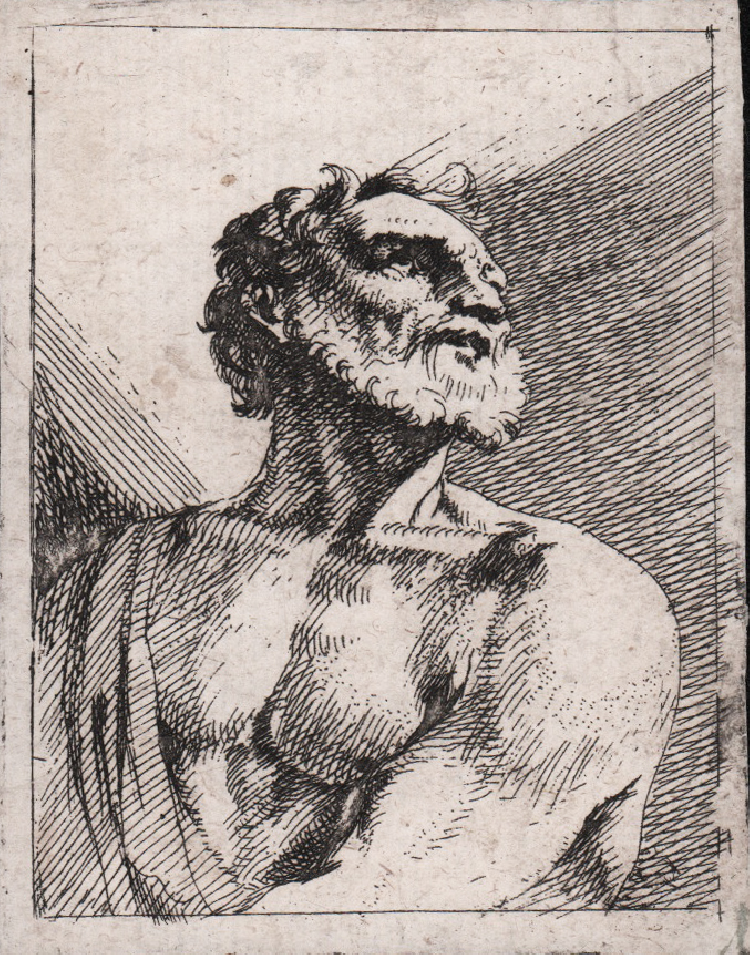



| Reference: | S44705 |
| Author | Johann Heinrich SCHÖNFELD |
| Year: | 1626 |
| Measures: | 60 x 75 mm |


| Reference: | S44705 |
| Author | Johann Heinrich SCHÖNFELD |
| Year: | 1626 |
| Measures: | 60 x 75 mm |
Bust of a bearded man; head turned upwards to right.
Etching, 1626, without signature.
From the Varie Teste de Capricci.
Johann Heinrich Schönfeld, was a German painter and engraver who was also very active in Italy. He trained at home with the painter Johann Sichelbein of Memmingen; beginning in 1633 he stayed extensively in Italy. He was first in Rome, where he was influenced by the classicist tendencies of Nicolas Poussin and the Baroque decorativism of Pietro da Cortona, then (from 1638) in Naples, where he made his own, reinterpreting it, the Caravaggio-like luminism of Bernardo Cavallino. During the Roman period, he frequented other German artists, certainly including Joachim von Sandrart and Johann Wilhelm Baur. He was also under the protection of Paolo Giordano II Orsini. Presumably from the beginning of his Roman sojourn, he joined under the nickname Trinangell the Schildersbent, an organization of Nordic, largely Dutch, artists. He was one of the most eminent German painters of the Baroque era, whose luminosity of touch and delicacy of color anticipated certain aspects of German Rococo art.
A fine impression, on contemporary laid paper, trimmed to the platemark or with thin margins, some ink spot, otherwise good condition. Rare.
Bibliografia
Hollstein, German engravings, etchings and woodcuts c.1400-1700 (7).
Johann Heinrich SCHÖNFELD (Biberach an der Riß, 23 marzo 1609 – Augusta, 1684)
|
Was a German painter in the Baroque style.
Instead, he received lessons in painting from Caspar Sichelbein [de] in Memmingen. Later, he took study trips to Stuttgart and Basel.
He was the son of Johann Baptist Schönfeld (?-1635); a goldsmith. From birth, he was blind in his left eye and could only use his right hand for simple tasks, so he was not trained as a goldsmith, as would have otherwise been the case. Instead, he received lessons in painting from Caspar Sichelbein [de] in Memmingen. Later, he took study trips to Stuttgart and Basel. In 1633, at the height of the Thirty Years' War, he fled to Italy. Originally, he lived in Rome, then moved to Naples around 1649. After a brief stay in Dresden he returned home in 1651. The following year, in Pfuhl (near Ulm) he married Anna Elisabetha Strauß. They had eight children together. Shortly after their marriage, they moved to Augsburg, where he became a citizen and a member of the Master's Guild. In the following years, he created many church paintings; notably at Würzburg Cathedral, where he painted Christ carrying the Cross and a likeness of Saint Leonard of Noblac. Both paintings burned during the bombing of Würzburg in World War II. In addition to religious works, he painted mythological and genre scenes.
|
Johann Heinrich SCHÖNFELD (Biberach an der Riß, 23 marzo 1609 – Augusta, 1684)
|
Was a German painter in the Baroque style.
Instead, he received lessons in painting from Caspar Sichelbein [de] in Memmingen. Later, he took study trips to Stuttgart and Basel.
He was the son of Johann Baptist Schönfeld (?-1635); a goldsmith. From birth, he was blind in his left eye and could only use his right hand for simple tasks, so he was not trained as a goldsmith, as would have otherwise been the case. Instead, he received lessons in painting from Caspar Sichelbein [de] in Memmingen. Later, he took study trips to Stuttgart and Basel. In 1633, at the height of the Thirty Years' War, he fled to Italy. Originally, he lived in Rome, then moved to Naples around 1649. After a brief stay in Dresden he returned home in 1651. The following year, in Pfuhl (near Ulm) he married Anna Elisabetha Strauß. They had eight children together. Shortly after their marriage, they moved to Augsburg, where he became a citizen and a member of the Master's Guild. In the following years, he created many church paintings; notably at Würzburg Cathedral, where he painted Christ carrying the Cross and a likeness of Saint Leonard of Noblac. Both paintings burned during the bombing of Würzburg in World War II. In addition to religious works, he painted mythological and genre scenes.
|